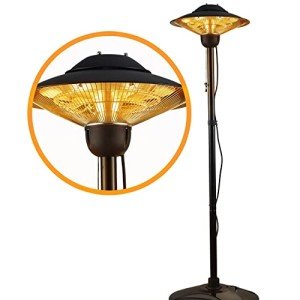The Top 5 Reasons People Win In The Patio Heat Lamp Electric Industry

How to Choose a Patio Heat Lamp Electric
When you want to heat your patio, you've got numerous options. Electric heaters are more efficient than propane models, which require fuel refills. They can be heated in a matter of minutes by pressing a button, or flicking the switch.
They don't emit gasses that could cause an health risk. Certain units come with adjustable heat settings to accommodate varying distances.
Type of Heater
You can relax in your outdoor living space all through the evening and all through the year by using the right patio heater. Patio heaters come in many different styles, including freestanding propane or natural gas models as well as ceiling or wall-mounted electric radiant heaters. The choice you make will depend on the dimensions of your area, the current power sources, and your personal preference.
Most patio heaters use electricity, natural or liquid gas to generate heat. They emit heat via convection heating in combination with radiant heating. Their output of heat is measured in watts and can be converted to British thermal units (BTUs) to compare. Some models can be adjusted in temperature settings that give you more flexibility.
A patio heat lamp is an electric burner on a pole with a perforated screen that reflect the flames and sends the heat downward to warm people, furniture and other objects. Some come with a reflector above the burner, which can be silvered to cut down the amount of heat lost upwards.
The most common kind of patio heater is a gas patio heater, is often seen in outdoor seating areas of bars and restaurants because they generate lots of heat quickly and spread equally across all directions. They are great for warming tables. They can be portable and run off a propane tank or plumbed into your natural gas line with the latter offering greater convenience and lower initial installation costs, but also requiring an ongoing cost of fuel.
Gas patio heaters are becoming more popular as more houses have natural gas lines. They are easy to set up, however they do require a specialized and functioning gas line to perform in a safe manner. hanging electric patio heater that are portable are available with extension hoses that can help overcome this limitation, but they can pose a tripping risk and can create an additional fire hazard when not in use.
Safety

Most electric patio heaters are safe to use in covered areas because they allow heat to radiate outward instead of upwards towards material that is combustible, such as the roof. They are not intended for use under an unprotected roof. The heater must be placed at least 6" away from the ceiling and 18" away from the wall adjacent to prevent fire hazards.
Gas and propane patio heaters are generally only safe to install in enclosed areas that have an enduring cover made for outdoor use. These types of covers are typically made from fire-retardant canvas and have a roof that can be closed. These kinds of patio heaters are prone to safety concerns related to the flames and fumes they create. They should be located away from objects that ignite like chairs and curtains.
Follow the instructions and safety measures of the manufacturer before installing a patio heater or heat lamp. Be sure to select the one with UL and CSA certifications. Also, read the owner's guide carefully. Make sure the heater is out of the reach of pets and children. Some patio heaters that are freestanding, such as EUROM, come with a built-in tipping safety that shuts down the device if it falls over.
If your patio heater is connected to a natural-gas line, you must check its condition periodically and have it tested by a certified professional for leaks. If the line needs to be replaced, make sure to hire a licensed plumber. A professional will be able to determine if the line is properly routed or if it should be routed through an underground pipe. A professional can make sure the heater in the patio is plugged into an outlet that is GFCI (ground fault circuit interrupter) rated to protect against electrical fires and shocks.
Installation
The size of the patio heater determines how much heat it radiates into the room. It is crucial that the heater is placed at a safe distance from the surface like plastic, which can deform as well as wood, which can become too hot. Depending on the model of heater, you can choose to place it on a wall or structure using standard mounting brackets. Certain models have a soft starter that lowers the peak current to protect your circuits.
